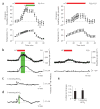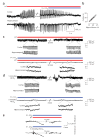Experimental febrile seizures are precipitated by a hyperthermia-induced respiratory alkalosis
- PMID: 16819552
- PMCID: PMC1698875
- DOI: 10.1038/nm1422
Experimental febrile seizures are precipitated by a hyperthermia-induced respiratory alkalosis
Abstract
Febrile seizures are frequent during early childhood, and prolonged (complex) febrile seizures are associated with an increased susceptibility to temporal lobe epilepsy. The pathophysiological consequences of febrile seizures have been extensively studied in rat pups exposed to hyperthermia. The mechanisms that trigger these seizures are unknown, however. A rise in brain pH is known to enhance neuronal excitability. Here we show that hyperthermia causes respiratory alkalosis in the immature brain, with a threshold of 0.2-0.3 pH units for seizure induction. Suppressing alkalosis with 5% ambient CO2 abolished seizures within 20 s. CO2 also prevented two long-term effects of hyperthermic seizures in the hippocampus: the upregulation of the I(h) current and the upregulation of CB1 receptor expression. The effects of hyperthermia were closely mimicked by intraperitoneal injection of bicarbonate. Our work indicates a mechanism for triggering hyperthermic seizures and suggests new strategies in the research and therapy of fever-related epileptic syndromes.
Conflict of interest statement
The authors declare that they have no competing financial interests.
Figures




Comment in
-
Putting the heat on febrile seizures.Nat Med. 2006 Jul;12(7):729-30. doi: 10.1038/nm0706-729. Nat Med. 2006. PMID: 16829913 No abstract available.
-
Respiratory alkalosis: "basic" mechanism of febrile seizures?Epilepsy Curr. 2007 Jan-Feb;7(1):25-7. doi: 10.1111/j.1535-7511.2007.00158.x. Epilepsy Curr. 2007. PMID: 17304348 Free PMC article. No abstract available.
References
-
- Hauser WA. The prevalence and incidence of convulsive disorders in children. Epilepsia. 1994;35(Suppl 2):S1–S6. - PubMed
-
- Tsuboi T. Epidemiology of febrile and afebrile convulsions in children in Japan. Neurology. 1984;34:175–181. - PubMed
-
- Sagar HJ, Oxbury JM. Hippocampal neuron loss in temporal lobe epilepsy: correlation with early childhood convulsions. Ann Neurol. 1987;22:334–340. - PubMed
-
- French JA, et al. Characteristics of medial temporal lobe epilepsy: I. Results of history and physical examination. Ann Neurol. 1993;34:774–780. - PubMed
-
- Holtzman D, Obana K, Olson J. Hyperthermia-induced seizures in the rat pup: a model for febrile convulsions in children. Science. 1981;213:1034–1036. - PubMed
Publication types
MeSH terms
Substances
Grants and funding
LinkOut - more resources
Full Text Sources
Other Literature Sources
Medical

